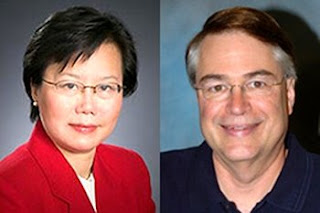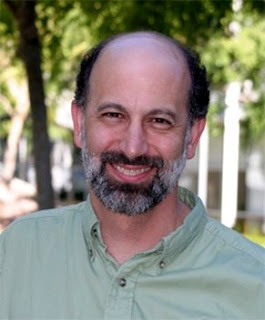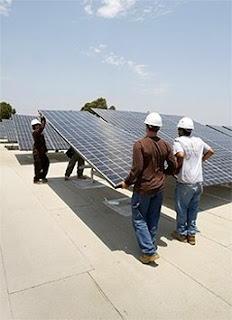“The timing of this conference could not be better, because we now have a timetable for compliance with California’s aggressive new rules to reduce carbon emissions,” said conference organizer Jerry Sheehan, director of government relations at Calit2. “We are looking forward to an open dialogue among policymakers, regulators, industry representatives and university researchers about how to reach these ambitious goals.”
The keynote speaker on the opening day of the conference will be Bill Weihl, Green Energy Czar at Google, Inc. Weihl leads Google’s efforts in energy efficiency and renewable energy, and spearheads the company’s drive to become carbon neutral. He is a former professor of computer science at MIT, as well as former chief technology officer of Akamai Technologies. Weihl also co-chairs the Climate Savers Computing Initiative.
In addition, CPUC President Michael R. Peevey will provide a keynote address on the second day of the event. “This event marks an important collaborative effort to advance strategies for sustainability and energy efficiency in the rapidly growing realm of information and communications technology,” said President Peevey. “Solutions can emerge to our complex emissions challenges when the foremost public policy makers, industry experts, research leaders, and global nonprofits continue to prioritize cooperation.” Other speakers from the public sector will include Darren Bouton, Deputy Cabinet Secretary to Gov. Schwarzenegger, and Anthony Eggert, Science and Technology Advisor to the Chair of ARB.
California-based industries will be well represented on the speaking roster. Senior officials scheduled to make presentations come from companies including Intel, Cisco Systems, Qualcomm, Hewlett-Packard, Pacific Gas & Electric, AT&T, IBM, General Motors, Silver Spring Networks, Fuel Cell Energy, Arup Group, CTG-Energetics, Realcom, Verrari, and others.
The opening session on Jan. 22 will focus on the policy framework of California’s AB 32 legislation, and in particular, the landmark act’s implications for companies in the ICT sector. Other sessions that day will explore the greening of power-hungry data centers – which have doubled their electricity use to 61 billion kilowatt-hours since 2000 – and reducing an organization’s ICT carbon footprint. The latter will focus on best practices in low-carbon ICT businesses, not just in California, but globally. Also on Jan. 22, Calit2 and other UC San Diego units will demonstrate some of the technologies implemented on the campus, including the largest microclimate monitoring system in the world.
On Jan. 23, the first panel will explore how the ICT sector can capitalize on advances in the energy sector and emerging technologies in the utility industry. Other sessions will address ICT and smart buildings, ‘intelligent’ transportation, and consumers, who are estimated to control or influence over 60 percent of all CO2 emissions.
The final session of the conference will explore the role that universities such as UC San Diego can play through research, development and the deployment of so-called ‘green cyberinfrastructure.’ Cyberinfrastructure accounts for a large portion of CO2 emissions at research universities, and it is estimated that higher education is responsible for between five and 10 percent of U.S. carbon emissions. Speakers on the IT panel include Calit2 research scientist Tom DeFanti.
“As science relies increasingly on data-intensive computing and networking, research universities are facing campus-wide crises of space, power and cooling,” said DeFanti, who leads the National Science Foundation-funded GreenLight project. “The GreenLight project is building instrumentation to measure data-center efficiency and devise optimal design strategies for getting more computational work done for fewer watts of energy.”
UC San Diego is one of the leading universities investigating energy efficiency in information technology and data centers. It is the only university member of Green Grid, an international consortium dedicated to reducing energy usage at data centers. The new wing of the San Diego Supercomputer Center at UC San Diego was designed and built to be 50 percent more energy efficient than California standards require, and UC San Diego also has one of the largest and most advanced university renewable energy programs. The campus will soon generate 7.8 megawatts of green energy, including wind, solar and biogas-powered fuel cell energy. By the end of 2009, green energy will provide 10 to 15 percent of the university’s annual electrical needs.
According to Steve Relyea, vice chancellor of business affairs at UC San Diego, the campus is going green with a vengeance. “We will be a zero waste campus by 2020,” said Relyea, who will brief attendees on the university’s Sustainability 2.0 program. “We are targeting climate neutrality by 2025 and have set specific targets and dates for procurement, water usage, transportation and other areas over the next decade. I really don’t know the limit of how green we can become, because I continue to be surprised by the ingenuity and resourcefulness of our faculty, students and staff.”
To attend “Greening the Internet Economy,” registration is required at the conference website. Admission for corporate participants is $200, or $100 for attendees from non-profit and government institutions. Faculty, students and staff from the two Calit2 campuses – UC San Diego and UC Irvine – will be admitted free of charge.
Contact: Doug Ramsey dramsey@ucsd.edu 858-822-5825, Terrie Prosper/CPUC, 415-703-1366. University of California - San Diego














No comments:
Post a Comment